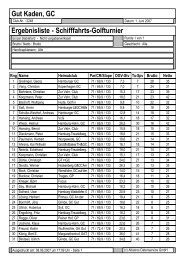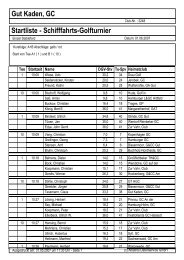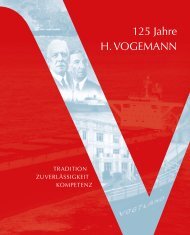You also want an ePaper? Increase the reach of your titles
YUMPU automatically turns print PDFs into web optimized ePapers that Google loves.
was available from the acquisition of the Auswanderermark. The normal<br />
rate of exchange was around RM 100,000 to 120,000, whereas we received<br />
around RM 300,000 in Auswanderermarks which we could use for the sale of<br />
a ship.<br />
At the same time, we were now conducting the purchase of the<br />
turbine steamship “Schwarzwald” from the Hamburg-America Line at a price<br />
of M 330,000 Hapag could not immediately approve the sale because the ship<br />
needed to first be released in America. The purchase of the steamship, which<br />
was brokered through the company Knöhr & Burchardt, was therefore concluded<br />
as released under reserve. When the release finally became finalised<br />
a few months later, Hapag would have preferred to withdraw from the sale<br />
of the steamship again as freight rates had in the meantime increased. But<br />
because the sale was firmly concluded, they could no longer withdraw.<br />
The “Auswanderermark” (Emigrant Mark)<br />
Controls on foreign exchange had already been in existence in Germany<br />
since 1931 and from 1933 were enforced more rigorously under<br />
National Socialist rule. The result of this was that significant partial<br />
payments became payable to the Deutsche Golddiskontbank (German<br />
Gold Discount Bank) when Reichsmark were exchanged for foreign<br />
currency on emigration. In 1934, already 65 % of the total money<br />
transferred had to be paid in levies, which in real terms meant that<br />
only 35 % could be exchanged. In 1939, eventually 96 % was due on<br />
emigration. This mechanism naturally worked the other way round: By<br />
bringing foreign currency into the country, large sums of Reichsmark<br />
could be acquired. In the afore-mentioned case, that of purchasing a<br />
ship with credit from Holland, it appears that just such a package deal<br />
had been made: Guilders were brought into the country, the sum paid<br />
out was in RM taken from those partial payments paid by emigrants<br />
to the Golddiskontbank. In this respect, the company would have actually<br />
profited from the foreign exchange control on the one hand and<br />
from the enforced emigration on the other.<br />
Information Dr. Frank Bajohr, Forschungsstelle für Zeitgeschichte (Research Centre for<br />
Contemporary History) Hamburg, September 2009<br />
Chapter 1 – History of the H. <strong>Vogemann</strong> Company 1886 – 1946 37<br />
1931<br />
The German government embarks<br />
on strict austerity measures to balance<br />
the budget.<br />
“Hoover Moratorium” for deferral<br />
of German reparation payments.<br />
The “National Opposition” joins forces to<br />
become the “Harzburger Front”.<br />
Bankruptcy of the Darmstädterand<br />
National Bank.<br />
Inauguration of the Empire State<br />
Building in New York.<br />
Carl Zuckmayer: “The Captain of<br />
Köpenick” (play).<br />
1932<br />
Number of unemployed at its<br />
highest level (6.1 million).<br />
Hindenburg is re-elected as<br />
Reichs President.<br />
The car manufacturers Audi,<br />
Horch, DKW and Wanderer join<br />
forces to become the Auto-Union.<br />
Gustaf Gründgens first appears<br />
in the role of Mephistopheles in<br />
Goethe's “Faust”.<br />
Hans Fallada: “Little Man,<br />
What Now?” (novel)<br />
Next page:<br />
The Port of Hamburg<br />
with the “Graf Zeppelin”<br />
airship. Panoramic mural<br />
by Erich Kips, 1931.






